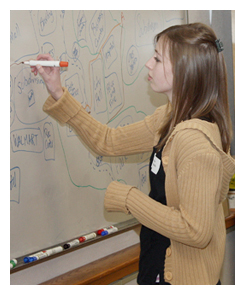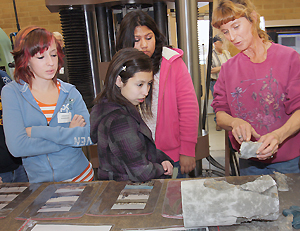

Middle school girls learn of career possibilities in engineering
Kristin Rodine, Idaho Statesman
Groups of eighth-grade girls sat at tables, intently folding and taping paper into different shapes and guessing which shape could support the most weight.
 The circular pillar was the easy winner, supporting at least five reams of paper. As the session moved on to other topics, one group of girls from Nampa's West Middle School stayed on the ream-stacking task.
The circular pillar was the easy winner, supporting at least five reams of paper. As the session moved on to other topics, one group of girls from Nampa's West Middle School stayed on the ream-stacking task.
Intrigued by the possibilities, they fashioned a tall, narrow paper cylinder that didn't collapse until the seventh ream touched down. They drew praise but weren't satisfied.
So they used the day's handouts, 14 pages strong, to form another pillar, then borrowed reams from the other students tables as they constructed an imposing tower that was 12 reams tall and which might have risen higher if the events adult organizers hadn't deemed it hazardously high.
The girls had caught the engineering bug.
And that, at least in part, was the point of Engineering Girls Day, a collaboration between the Nampa School District and the Idaho Transportation Department.
About 30 girls from Nampa's four middle schools spent most of Friday at ITD headquarters in Boise, hearing from many of the departments female engineers and touring the labs where technicians scrutinize the materials for Idaho road projects to make sure they will stand the tests of time and 18-wheelers.
After a break for pizza, the girls got to do some experiments of their own.
"It was fun," a contingent from Lone Star Middle School declared in unison.
"This was the best part," said West eighth-grader Makayla McKibben, one of the chief engineers behind the 12-ream tower. "It's so hands-on."
Many of the participating girls are in Nampa's Project Lead the Way, a middle-school precursor to the pre-engineering academy based at Nampa's Columbia High School, district spokeswoman Allison Westfall said. Others were selected because of their interest in math and/or science.
THE OPPORTUNITIES ARE AMAZING
The Idaho Transportation Department has partnered with Nampa schools for four years, frequently lending engineers expertise to classrooms. But this was the first event geared solely for girls.
Erika Bowen, an Intelligent Transportation Systems engineer, suggested the idea and said she'd love to see more women enter the field and the transportation departments work force.
"I think it's becoming more popular and less intimidating to take all the math and stuff," Bowen said.
Megan Kautz, a recent College of Idaho graduate who got a technician job at ITD and has applied for the department's Engineers in Training program, encouraged the eighth-graders to keep engineering in mind.
"The opportunities for us as women in this field are amazing," Kautz said.
Scholarships abound, she said, and employers are eager to add more women.
"And besides," she said, "civil engineers get to do some really sweet stuff."
Kautz showed slides of engineering feats, including a roadway embedded with solar cells and a British bridge that can move out of the way to let tall ships pass. Engineers have had a hand in designing everything from a roller coaster to Bronco Stadium to the ski lifts at Bogus Basin, Technical Engineer Shanon Murgoitio said.
 GET PAID TO BREAK STUFF
GET PAID TO BREAK STUFF
In the ITD labs, technicians and engineers test the properties of rocks, metal, road mix, chemical de-icer and more.
The girls watched structural technicians stretch rebar until it snapped, creating a noise akin to a rifle-shot, and applied pressure to a batch of concrete to see if it was strong enough to withstand years of truck traffic.
"Mama used to tell me not to break things," Senior Transportation Technician Mark Humphrey said, grinning. "Now I get paid for it."
Later, West Middle School student Xochitl Sanchez assessed the ITD visit by saying the best part was when we got to break things in one of the labs.
The girls watched rollers simulate the wear and tear of truck tires on road mix pucks the size of short coffee cans. And they learned how precisely rocks and asphalt are measured and tested to make sure the blend will hold up.
"These are torture tests that can do in a few hours what traffic will do in 20 years," Assistant Materials Engineer Mike Santi said. "It needs to be hard enough not to rut in hot weather and soft enough not to crack in cold weather."
Of the 11 Engineering Girls participants who talked to a reporter Friday, all said they are interested in exploring a possible future in engineering.
"I've thought about it before," Lone Star Middle School eighth-grader Kylie Gish said. "I like designing stuff. And I like math."
Additional information
Girls, engineers and the numbers
The ITD employs 139 engineers in various capacities throughout the state. Of those, 19 are women. Two of those women are in the earliest stages of their career as part of ITD's Engineers in Training program. And even there, females are in a distinct minority two of 16.
In 2007, the National Science Foundation reported that women make up 8 percent of the overall engineering work force in the United States and 18 percent of undergraduate students in engineering colleges.
At Nampa schools pre-engineering academy, one of about a dozen across the state, 20 percent of the students are girls. In the Treasure Valley, Boise, Meridian and Caldwell also have pre-engineering programs in their high schools.
More girls are joining the pre-engineering programs in Idaho schools, but they are still a significant minority, said Dick Ledington, director of research for Idaho's Division of Professional-Technical Education.
Statistics weren't readily available to show how many Idaho girls are enrolled in pre-engineering programs, Ledington said. The state groups engineering and technology programs together for record-keeping. Last year that total statewide enrollment was 9,089 students - 23 percent of them female.
"Information Technology is more like 50-50, and engineering is skewed more toward the male," Ledington said.
Gone are the days, he said, when only girls could take home economics and only boys could take woodshop or join FFA.
The state must report to the federal government all non-traditional student enrollments in fields where one gender makes up less than 25 percent of those employed in the profession, Ledington said. Girls are nontraditional students in such fields as engineering and agriculture, he said, and boys count as nontraditional students for nursing and elementary education.
Statewide, he said, the percentage of nontraditional students enrolled in all such programs is 37 percent - easily exceeding the federal requirement. "I think our programs are very well situated right now," Ledington said.


(Top) ITD rolled out the welcome mat and a lift truck for a group of young women from four Nampa middle schools that attended ITD’s Engineering Girls Day.(Above right) One challenge for the engineer girls was to map a road through a simulated city the group developed, accounting for wetland and other environmental issues. (Above left) Materials Lab personnel provided the department’s young guests with many demonstrations(Bottom left and right) The young women attending the day’s demonstrations got an opportunity to learn how weight breaks some materials and why.
Published 3-4-2011